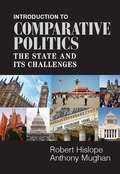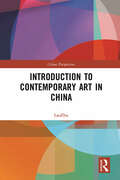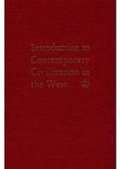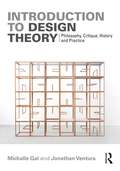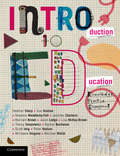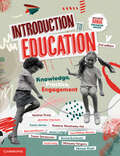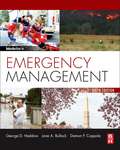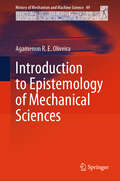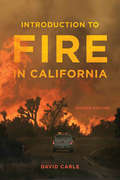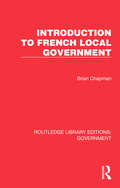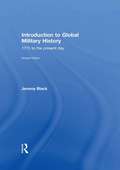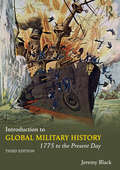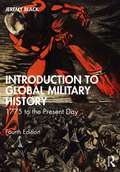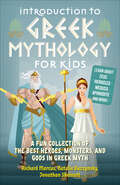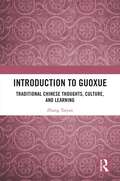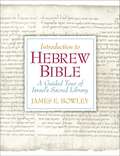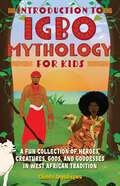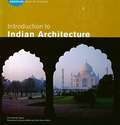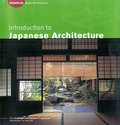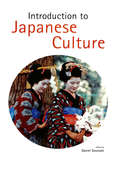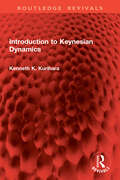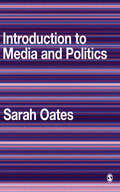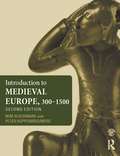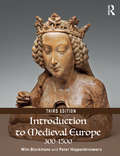- Table View
- List View
Introduction to Comparative Politics
by Robert Hislope Anthony MughanThis stimulating and accessible introduction to comparative politics offers a fresh perspective on the fundamentals of political science. Its central theme is the enduring political significance of the modern state despite severe challenges to its sovereignty. There are three main sections to the book. The first traces the origins and meaning of the state and proceeds to explore its relationship to the practice of politics. The second examines how states are governed and compares patterns of governance found in the two major regime types in the world today, democracy and authoritarianism. The last section discusses several contemporary challenges – globalization, ethnic nationalism, terrorism and organized crime – to state sovereignty. Designed to appeal to students and professors alike, this lively text engages readers as it traces states' struggles against the mutually reinforcing pressures of global economic and political interdependence, fragmented identities and secessionism, transnational criminal networks, and terrorism.
Introduction to Contemporary Art in China (China Perspectives)
by Lao ZhuThe book is a collection of fifteen introductory essays excerpted from the Annual of Contemporary Art in China, covering the years from 2005 to 2019, showcasing the development and changing landscapes of contemporary art in China. The Annual documents exhibitions, events, creative practices, and critical literature concerning contemporary art in China since 2005. Based on archival documentation and statistics data from these annuals, notable phenomena, events, and discourses from a given year, as well as key works and artists are reviewed in each introduction, with no ideological or market-driven undertone. The author unravels industrial and institutional factors, while also broaching important issues of abstract art, new media art and so on, and probing the historical and socio-cultural context as well. In this regard, the book offers a panorama of contemporary Chinese art and critically engages with the art scene in China, including Hongkong, Taiwan, and among the Chinese diaspora. The title will appeal to scholars, students and general readers interested in contemporary art history, art criticism, contemporary Chinese art, iconography, and contemporary art theory.
Introduction to Contemporary Civilization in the West: Volume 1
by Columbia College Contemporary Civilization StaffCivilization -- History -- Sources.
Introduction to Design Theory: Philosophy, Critique, History and Practice
by Jonathan Ventura Michalle GalIntroduction to Design Theory introduces a comprehensive, systematic, and didactic outline of the discourse of design. Designed both as a course book and a source for research, this textbook methodically covers the central concepts of design theory, definitions of design, its historical milestones, and its relations to culture, industry, body, ecology, language, society, gender and ideology. Demonstrated by a shift towards the importance of the sociocultural context in which products are manufactured and embedded, this book showcases design theory as an emerging sub-discipline of design, unique in its practice-based approach and its broad perception of design. It offers an in-depth understanding of the central concepts, such as "form" and "function", "theory" and "practice", through a discussion of key case studies and historical examples, such as the advent of the view of design in antiquity, the introduction of mass production to modernist design or the ideological shifts in design in the mid-twentieth century, as well as analytical tools for further dissection and learning in practice. With a focus on a combination of several theoretical knowledge foundations — aesthetics and philosophy, critical theories, cultural studies, design history and design anthropology — the reader is enabled to approach design as a central pivot around which contemporary culture revolves, reflecting, reaffirming or challenging social and cultural structures. Aimed towards undergraduate and postgraduate students, as well as teachers and scholars, from across the design disciplines, Introduction to Design Theory invites readers to engage with design from an interdisciplinary perspective, departing from the traditional academic compartmentalisation of practice, history and philosophy.
Introduction to Education: Knowledge, Practice, Engagement
by Michael Walsh Peter Hudson Bernard Brown Heather Sharp Sue Hudson Noelene Weatherby-Fell Jennifer Charteris Jason Lodge Lisa McKay-Brown Tracey Sempowicz Rachel Buchanan Scott Imig Michaela VerganoIntroduction to Education provides pre-service teachers with an overview of the context, craft and practice of teaching in Australian schools as they commence the journey from learner to classroom teacher. Each chapter poses questions about the nature of teaching students, and guides readers though the Australian Professional Standards for Teachers. Incorporating recent research and theoretical literature, Introduction to Education presents a critical consideration of the professional, policy and curriculum contexts of teaching in Australia. The book covers theoretical topics in chapters addressing assessment, planning, safe learning environments, and working with colleagues, families, carers and communities. More practical chapters discuss professional experience and building a career after graduation. Rigorous in conception and practical in scope, Introduction to Education welcomes new educators to the theory and practical elements of teaching, learning, and professional practice.
Introduction to Education: Knowledge, Practice, Engagement
by Michael Walsh Sarah James Bernard Brown Heather Sharp Noelene Weatherby-Fell Jennifer Charteris Jason Lodge Lisa McKay-Brown Tracey Sempowicz Rachel Buchanan Scott Imig Michaela VerganoThe transition from student to classroom teacher presents many opportunities and challenges. Introduction to Education welcomes pre-service teachers to the field of education, providing an overview of the context, craft and practice of teaching in Australian schools. Each chapter poses a question about the nature of teaching and explores authentic classroom examples, contemporary research and literature, and the professional, policy and curriculum contexts of teaching. Thoroughly updated, the second edition continues to cover both theoretical and practical topics, with chapters addressing assessment, planning, safe learning environments, professional experience, and working with colleagues, families, caregivers and communities. Each chapter features: chapter opening stimulus materials and questions to activate prior learning and challenge assumptions; connections to policy and research with questions to encourage critical thinking and professional literacy; voices of educators and students that provide authentic classroom examples of the practical application of theory.
Introduction to Emergency Management (6th Edition)
by Damon P. Coppola Jane A. Bullock George D. HaddowIntroduction to Emergency Management sets the standard for excellence in the field and has educated a generation of emergency managers. Haddow, Bullock, and Coppola return for the sixth edition with an emphasis on climate change as a major hazard. Fully updated throughout for new regulations and workflows, with new case studies covering the latest in best practices, this classic textbook prepares students for the challenges of a career in emergency management. Expanded information on disaster recovery coordination structures; Emphasis on climate change as a key hazard faced by disaster managers; Coverage of social media as critical tool in emergency management; Fully updated throughout for the latest regulations and workflows; New examples and case studies throughout; Updated ancillaries to keep course instruction fresh.
Introduction to Epistemology of Mechanical Sciences (History of Mechanism and Machine Science #49)
by Agamenon R. OliveiraThis book investigates the development of mechanical sciences with a focus on epistemological issues. It examines the precursors and fundamental milestones of Newton's theory of motion, a geometry of motion since Greek antiquity, the influences of Robert Hooke on Newton's studies on the orbital motion of the planets, and finally, the orbital motion model with a central force inversely proportional to the square of the distance to this centre. By looking at the development of mechanics throughout history, especially with a careful look at epistemological issues, the book highlights the multiple relationships that the mechanical sciences build with other sciences, the economy, and the popular culture.
Introduction to Fire in California: Second Edition (California Natural History Guides)
by David CarleThe essential guide to California's long relationship with fire, updated for the climate-change generation. What is fire? How are wildfires ignited? How do California's weather and topography influence fire? How did Indigenous people use fire on the land we now call California? David Carle's clearly written, dramatically illustrated first edition of Introduction to Fire in California helped Californians, including the millions who live near naturally flammable wildlands, better understand their own place in the state's landscape. In this revised edition, Carle covers the basics of fire ecology; looks at the effects of fire on people, wildlife, soil, water, and air; discusses fire-fighting organizations and land-management agencies; and explains how to prepare for an emergency and what to do when one occurs. This second edition brings the wildfire story up to the year 2020, with information about recent extreme and deadly fire events and the evidence that climate change is swiftly changing the wildfire story in California. This update reflects current debates about California's future as a climate-crisis leader facing massive, annual natural disasters; the future of California development and housing; and the critically necessary alternatives to traditional energy options. Features:A larger, more reader-friendly page formatMore than 110 color illustrations and mapsAn overview of major wildfires in California's historyAn updated and expanded discussion of the effect of climate change on fires in natural landscapesTips on what to do before, during, and after firesDiscussion of utility companies and massive power shutoffs
Introduction to French Local Government (Routledge Library Editions: Government)
by Brian ChapmanOriginally published in 1953, this was the first post-War study in either English or French of the institutions and law relating to French local government and on the practice of French local administration. It is a study in political science and therefore, although the basic laws governing local institutions are dealt with in some detail, the aim is to give a picture of those institutions at work in the middle of the 20th Century. The book assumes no prior knowledge of the subject and will be of interest to students of French government and comparative political institutions.
Introduction to Global Military History: 1775 to the Present Day
by Jeremy BlackThis lucid account of military developments around the modern world begins with the American War of Independence and the French revolutionary wars and continues chronologically to the latest 21st century conflicts. It combines determinedly global coverage with thought-provoking analysis not only of the military aspects of conflict but also its social, cultural, political and economic dimensions and consequences. By placing familiar events alongside the largely unknown, the reader is forced to reassess the standard grand narrative of military history that rests on assumptions of Western cultural and technological superiority. It will be essential reading for students worldwide, whether studying modern military history, modern world history, history and international relations or war and society. This fully updated second edition includes: chapter introductions and conclusions to assist study and revision 'Voices of War' sourced extracts from the field of conflict case studies in each chapter to support the narrative and provoke discussion a 12-page colour map section and over 20 other integrated maps annotated references from the latest publications in the field
Introduction to Global Military History: 1775 to the Present Day
by Jeremy BlackIntroduction to Global Military History provides a lucid and comprehensive account of military developments around the modern world from the eighteenth century up to the present day. Beginning with the background to the American War of Independence and the French Revolutionary wars and ending with the recent conflicts of the twenty-first century, this third edition combines fully up-to-date global coverage with close analysis not only of the military aspects of war but also its social, cultural, political and economic dimensions and repercussions. The new edition includes a fully revised chapter on conflicts during the eighteenth century, updated coverage of events post-1990 and increased coverage of non-Western conflicts to provide a truly international account of the varied and changing nature of modern military history. Covering lesser-known conflicts as well as the familiar wars of history and illustrated throughout with maps, primary source extracts and case studies, it is essential reading for all students of modern military history and international relations.
Introduction to Global Military History: 1775 to the Present Day
by Jeremy BlackNow in its fourth edition, Introduction to Global Military History is an accessible, up-to-date account of modern warfare from the eighteenth century to the present.The book engages with the social, cultural, political and economic contexts of war, examining the causes and consequences of conflict beyond national and chronological boundaries. It challenges the dominant Western-centric, technologically focused view of military history and instead emphasises the ranges of circumstances faced by both Western and non-Western powers and the absence of any one direction of development. The chapters present integrated discussions of land, naval and air conflicts, addressing continuities and the ways in which common experiences affected different spheres. This edition revises the text throughout, has increased focus on the developments of the 2000s and 2010s, and adds a new chapter on the 2020s.Supported by a variety of illustrations, maps and case studies, this study is a valuable resource for students of military history and general readers alike.
Introduction to Greek Mythology for Kids: A Fun Collection of the Best Heroes, Monsters, and Gods in Greek Myth
by Richard Marcus Natalie Buczynsky Jonathan ShelnuttDiscover the exciting and fascinating world of Greek and Roman gods, goddesses, monsters, and heroes, from Zeus and Athena to Hercules, Medusa, and more!Take a journey through Mount Olympus, Ancient Greece, and Ancient Rome with this collection of the greatest tales found in Greek and Roman mythology. From origin stories to family drama, you&’ll learn about the most powerful Olympic gods including Zeus, Hera, Poseidon, Athena, Apollo, Artemis, Aphrodite, Hades, and more. But this book has more than just gods and goddesses! You&’ll also discover the dangerous and intriguing world of ancient monsters, fantastical creatures, and mortal heroes that populate some of the most awesome stories from the time, including: Atlas, who carries the weight of the world on his shoulders Kronos, a Titan who swallows his newborn children Persephone, a kidnapped goddess who becomes queen of the Underworld Minotaur, a half-bull, half-man imprisoned in a labyrinth Hydra, a poisonous serpent who grows two heads when one is severed Sirens, sea nymphs whose irresistible singing lures sailors to their doom All of these tales and more are written in a fun, kid-friendly manner, perfect for children interested in history or for fans of the Percy Jackson series.
Introduction to Guoxue: Traditional Chinese Thoughts, Culture, and Learning
by Zhang TaiyanThis book is a collection of Zhang Taiyan's lectures on traditional Chinese thoughts, culture, and learning. Zhang Taiyan is known for his role as an active proponent of Guoxue (Chinese learning) in modern China. This title comprises the transcripts of a series of his lectures on Guoxue given in Shanghai between April and June 1922, and serves as an insightful and influential companion to Guoxue. It systematically introduces the research methods of Guoxue and the development and schools of Chinese classical studies, Chinese philosophy, and Chinese literature, and provides a brilliant analysis of representative figures and works from various periods. It also touches on a wide range of topics in Chinese history, philology, paleography, bibliology, and geography. This book provides Guoxue with many new and thought-provoking ideas and plays a crucial role in the dissemination of Guoxue throughout the world. This title will be essential reading for students and scholars of Sinology and Chinese Studies, as well as for the general public interested in traditional Chinese culture.
Introduction to Hebrew Bible: A Guided Tour of Israel's Sacred Library
by James E. BowleyWelcoming readers into the world, culture, history, and literature of the library of Judaism, this volume provides a solid and rich overview of the content of each book, including its historical background. Attractively formatted as a museum or library tour, the book gives readers a sense of the plurality and richness of the on-going traditions of the biblical faith communities and shows how the three Abrahamic world religions of Judaism, Christianity, and Islam have all used the Old Testament. The library tour begins with the layout, an historical and critical overview of the books, prophets and writings and a provides look at the faith-communities that use the Bible. For Bible novices and Bible experts alike interested in a comprehensive tour of its Books.
Introduction to Igbo Mythology for Kids: A Fun Collection of Heroes, Creatures, Gods, and Goddesses in West African Tradition
by Chinelo AnyadiegwuImmerse yourself in the vibrant world of Igbo heroes, deities, creatures, folktales, and myths, including Chineke the creator, Ana, Igwe, Anyanwu, Ekwensu, and more, plus the story of the first mermaid, the legend of Udenolu the shapeshifting crow, and the story of the tortoise and the Lion King.The first definitive collection of Igbo legends and traditions for kids, this book explores the mythological origins of the Igbo people, the ancient Nri Kingdom, and Igbo cosmology before delving into the Alusi, or the core Igbo deities. Following this introduction to the pantheon of gods and goddesses, a collection of the most popular Igbo myths, folktales, and legends will immerse kids in exciting stories of tricksters, shapeshifters, and heroes, including: The Wrestler Whose Back Never Touched the Ground Ojiugo, the Rare Gem The Tortoise and the Birds, or The Origin Story of Sea Turtles Ngwele Aghuli, Why the Crocodile Lives Alone How Death Came to Be And more! The perfect book for kids who are fascinated by Greek mythology or love the Rick Riordan series, Introduction to Igbo Mythology for Kids offers a fun look into the stories, history, and figures that characterize Igbo culture.
Introduction to Indian Architecture
by Bindia Thapar Surat Kumar Manto Suparna BhallaTake a journey through Indian architecture from the dawn of civilization to the present with this colorful, attractive survey.The architecture of India reflects both the cultural diversity of the subcontinent and its rich political and historical inheritance. In this guide, the various strands of this rich architectural history, from the dawn of civilization to modern times, are beautifully presented in word and picture. Readers are taken on a fascinating tour of Indus Valley civilization, early Vedic traditions, Hindu, Jain, Mughal, regional, colonial and post-independence architectural styles. Themes such as water architecture and the architecture of science also figure prominently, giving many westerners their first glimpse of these styles.The informative text, complemented by 400 photographs, watercolors, maps and plans, provide compelling evidence of India's influence on building design throughout history.
Introduction to Japanese Architecture
by David Young Michiko Young Tan Hong YewIntroduction to Japanese Architecture provides an overview of Japanese architecture in its historical and cultural context. It begins with a discussion of prehistoric dwellings and concludes with a description of contemporary trends in areas as diverse as country inns, underground malls, and love hotels. The intervening 12,000 years are analyzed in reference to major changes in architecture caused by Buddhist and indigenous influences, feudalism, and finally the influence of Western culture in the 19th century.
Introduction to Japanese Culture
by Daniel SosnoskiThe richness of Japan's history is renowned worldwide. The heritage of culture that its society has produced and passed on to future generations is one of Japan's greatest accomplishments. In Introduction to Japanese Culture, you'll read an overview, through sixty-eight original and informative essays, of Japan's most notable cultural achievements, including:Religion, Zen Buddhism, arranged marriages and BushidoDrama and Art--from pottery, painting and calligraphy to haiku, kabuki and karateCuisine--everything from rice to raw fishHome and Recreation, from board games such as Go to origami, kimonos and Japanese gardensThe Japan of today is a fully modern, Westernized society in nearly every regard. Even so, the elements of an earlier age are clearly visible in the country's arts, festivals, and customs. This book focuses on the essential constants that remain in present-day Japan and their counterparts in Western culture.Edited by Daniel Sosnoski, these well-researched articles, color photographs, and line illustrations provide a compact guide to aspects of Japan that often puzzle the outside observer. Introduction to Japanese Culture is wonderfully informative, a needed primer on the cultural make-up and behaviors of the Japanese.
Introduction to Japanese Culture
by Daniel SosnoskiFeaturing full-color photographs and illustrations throughout this text is a comprehensive guide to Japanese culture.The richness of Japan's history is renowned worldwide. The heritage of culture that its society has produced and passed on to future generations is one of Japan's greatest accomplishments. In Introduction to Japanese Culture, you'll read an overview, through sixty-eight original and informative essays, of Japan's most notable cultural achievements, including:Religion, Zen Buddhism, arranged marriages and BushidoDrama and Art-from pottery, painting and calligraphy to haiku, kabuki and karateCuisine-everything from rice to raw fishHome and Recreation, from board games such as Go to origami, kimonos and Japanese gardensThe Japan of today is a fully modern, Westernized society in nearly every regard. Even so, the elements of an earlier age are clearly visible in the country's arts, festivals, and customs. This book focuses on the essential constants that remain in present-day Japan and their counterparts in Western culture.Edited by Daniel Sosnoski, these well-researched articles, color photographs, and line illustrations provide a compact guide to aspects of Japan that often puzzle the outside observer. Introduction to Japanese Culture is wonderfully informative, a needed primer on the cultural make-up and behaviors of the Japanese.
Introduction to Keynesian Dynamics (Routledge Revivals)
by Kenneth K. KuriharaFirst published in 1956, Introduction to Keynesian Dynamics provides a coherent and compact study of macro-dynamic analysis in general and particularly the two outstanding ‘post Keynesian’ developments in the field- 1) dynamic theories of cyclical fluctuations and 2) secular growth analysis.Part I of this book provides a general base of reference for substantive analysis. Part II contains fairly definitive materials, dealing as it does with the modus operandi of cyclical fluctuations, the dynamics of inflation and deflation, the stability conditions of equilibrium, a nonlinear model of dynamic switches, the interaction of endogenous and exogenous variables, and international oscillatory processes. Part III explores the technical possibility and difficulty of securing maximum economic growth with minimum instability. The concluding chapter critically examines the twin problems of steady growth for advanced economies and rapid development for underdeveloped economies in a way that would suggest a common solution. This is a must read for students of economics and economic history.
Introduction to Media and Politics
by Sarah Oates'...a lively introduction to media and politics, with timely chapters on the media, war and terrorism and the internet. If you want to know why media matters in politics this is a great place to start' - Dr Margaret Scammell, London School of Economics and Political Science 'This book has the truly international perspective that helps to put politics and media in the context of current world events...a unique and valuable text' - Professor Lynda Lee Kaid, University of Florida '...a new and promising perspective to the study of media and politics in a comparative dimension' - Professor Paolo Mancini, Università di Perugia Introduction to Media and Politics draws together evidence from the United States, the United Kingdom, Russia and beyond to provide students with an understanding of the relationship between the media and the political sphere. This highly accessible text: - balances theory with case studies on elections, war, terrorism, and the emerging role of the Internet, enabling the reader to think critically about how the media should work in the service of democracy. - places the study of media and politics in a comparative perspective, allowing the reader to consider how the same media institutions - including commercial and public service broadcasting, paid political advertising, and war coverage - function in different countries. This text is essential reading for advanced undergraduate and postgraduate students of media and politics.
Introduction to Medieval Europe 300–1500
by Wim Blockmans Peter HoppenbrouwersIntroduction to Medieval Europe 300-1500 provides a comprehensive survey of this complex and varied formative period of European history. Covering themes as diverse as barbarian migrations, the impact of Christianization, the formation of nations and states, the emergence of an expansionist commercial economy, the growth of cities, the Crusades, the effects of plague, and the intellectual and cultural life of the Middle Ages, the book explores the driving forces behind the formation of medieval society and the directions in which it developed and changed. In doing this, the authors cover a wide geographic expanse, including Western interactions with the Byzantine Empire and the Islamic World. ? Now in full colour, this second edition contains a wealth of new features that help to bring this fascinating era to life, including: A detailed timeline of the period, putting key events into context Primary source case boxes Full colour illustrations throughout New improved maps A glossary of terms Annotated suggestions for further reading The book is supported by a free companion website with resources including, for instructors, assignable discussion questions and all of the images and maps in the book available to download, and for students, a comparative interactive timeline of the period and links to useful websites. The website can be found at www.routledge.com/cw/blockmans.? Clear and stimulating, the second edition of Introduction to Medieval Europe is the ideal companion to studying Europe in the Middle Ages at undergraduate level.
Introduction to Medieval Europe 300–1500
by Wim Blockmans Peter HoppenbrouwersIntroduction to Medieval Europe 300–1500 provides a comprehensive survey of this complex and varied formative period of European history, covering themes as diverse as barbarian migrations, the impact of Christianisation, the formation of nations and states, the emergence of an expansionist commercial economy, the growth of cities, the Crusades, the effects of plague, and the intellectual and cultural life of the Middle Ages. The book explores the driving forces behind the formation of medieval society and the directions in which it developed and changed. In doing this, the authors cover a wide geographic expanse, including Western interactions with the Byzantine Empire and the Islamic World. This third edition contains a wealth of new features that help to bring this fascinating era to life, including: In the book: A number of new maps and images to further understanding of the period Clear signposting and extended discussions of key topics such as feudalism and gender Expanded geographic coverage into Eastern Europe and the Middle East On the companion website: An updated, comparative and interactive timeline, highlighting surprising synchronicities in medieval history, and annotated links to useful websites A list of movies, television series and novels related to the Middle Ages, accompanied by introductions and commentaries Assignable discussion questions and the maps, plates, figures and tables from the book available to download and use in the classroom Clear and stimulating, the third edition of Introduction to Medieval Europe is the ideal companion to studying Europe in the Middle Ages at undergraduate level.
